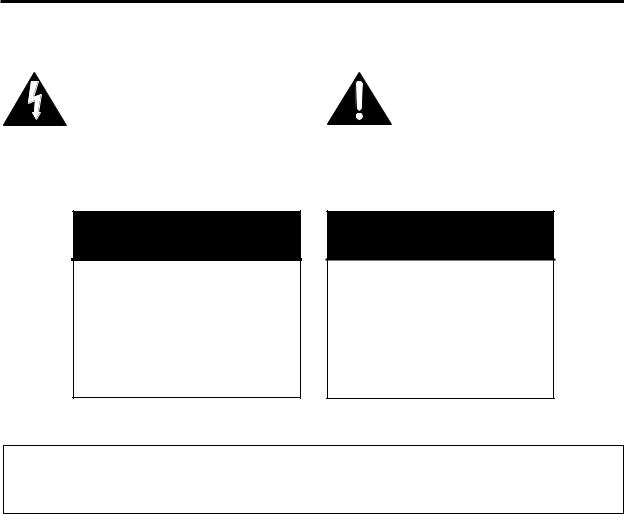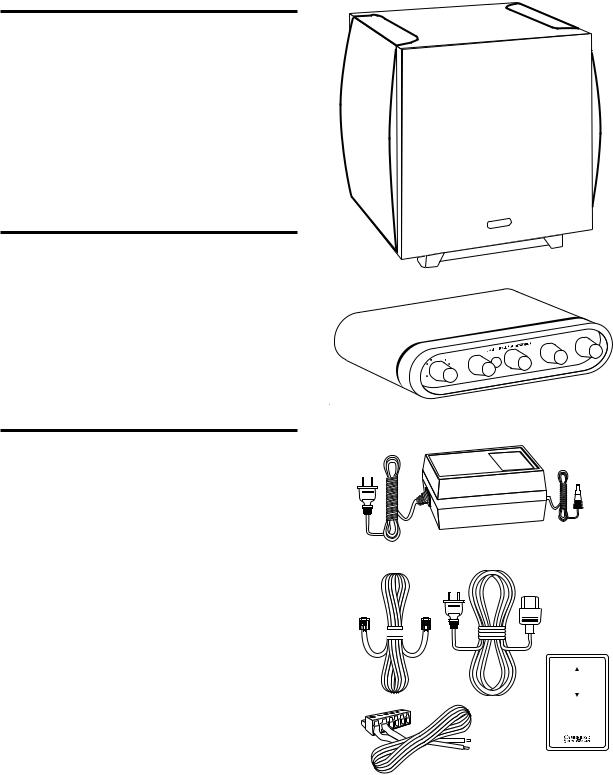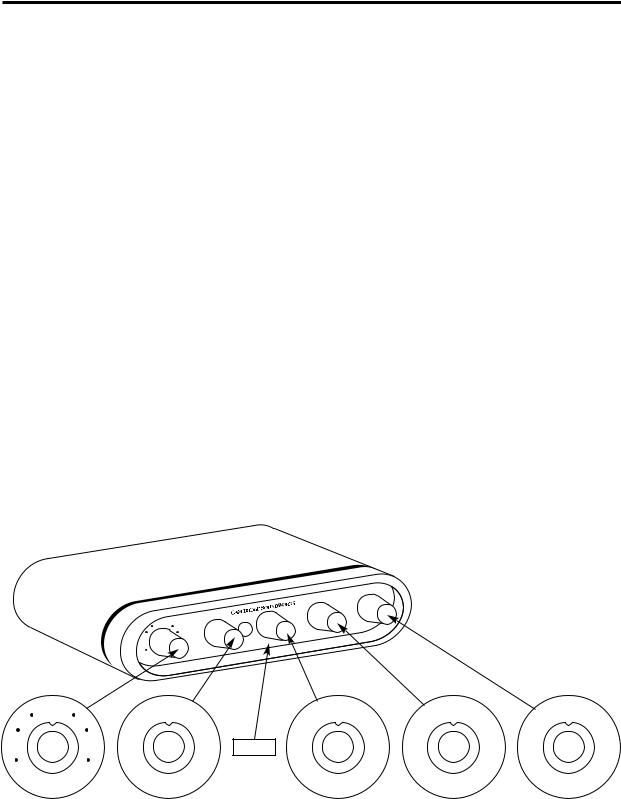Cambridge SoundWorks P500 User Manual




 ™
™
P 1 0 0 0 a n d P 5 0 0 S u b w o o f e r s
User Manual
®

The lightning flash with arrowhead, within an equilateral triangle, is intended to alert the user to the presence of uninsulated “dangerous voltage” within the product’s enclosure that may be of sufficient magnitude to constitute risk of electric shock to persons.
The exclamation point within an equilateral triangle is intended to alert the user to the presence of important operating and maintenance (servicing) instructions in the literature accompanying this product
WARNING
DO NOT OPEN
TO PREVENT THE RISK OF ELECTRIC
SHOCK, DO NOT REMOVE
SUBWOOFER’S COVER. NO USERSERVICEABLE PARTS INSIDE.
REFER SERVICING TO QUALIFIED
SERVICE PERSONNEL.
AVISIQUE
POUR EVITER TOUT RISQUE DE CHOC ELECTRIQUE, NE PAS DEMONTER LE COUVERCLE DU HAUT PARLEUR. AUCUN ENTRETIEN DES PIECES INTERIEURES N’EST REQUIS.TOUT SERVICE D’ENTRETIEN NE DOIT ETRE EFFECTUE QUE PAR DU PERSONNEL D’ENTRETIEN QUALIFIE.
READ AND HEED IMPORTANT SAFETY WARNING ON BACK OF SUBWOOFER ENCLOSURE
CAUTION:
TO PREVENT ELECTRIC SHOCK, MATCH WIDE BLADE OF PLUG TO WIDE SLOT, INSERT FULLY.
ATTENTION:
POUR EVITER LES CHOCS ELECTRIQUES, INTRODUIRE LA LAME LA PLUS LARGE DE LA FICHE DANS LA BORNE CORRESPONDANTE DE LA PRISE ET POUSSER JUSQU’AU FOND.
IMPORTANT NOTICE:
THE SERIAL NUMBER FOR THE SUBWOOFER IS LOCATED ON THE SUBWOOFER’S CONTROL PANEL. PLEASE WRITE THIS NUMBER DOWN AND KEEP IT IN A SECURE AREA. THIS IS FOR YOUR SECURITY.
2

IMPORTANT SAFETY INSTRUCTIONS
READ INSTRUCTIONS – All safety and operating instructions should be read before the subwoofer is operated.
RETAIN INSTRUCTIONS – The safety and operating instructions should be retained for future reference.
HEED WARNINGS – All warnings on the subwoofer and in the operating instructions should be adhered to.
FOLLOW INSTRUCTIONS – All operating and use instructions should be followed.
CLEANING – Unplug the subwoofer or control module from the wall outlet or other power source before cleaning. Use a damp cloth for cleaning.
ATTACHMENTS – Do not use any adapters or attachments not recommended by Cambridge SoundWorks as they may cause hazards.
WATER AND MOISTURE – Do not use the subwoofer or control module near water-for example, near a bath tub, wash bowl, kitchen sink, or laundry tub; in a wet basement; or near a swimming pool or other similar areas.
ACCESSORIES – Do not place the subwoofer on an unstable cart, stand, tripod, bracket, or table. The subwoofer may fall, causing serious injury to a child or adult and serious damage to the product.
VENTILATION – Slots, openings and metal fins in the cabinet are provided for ventilation, to ensure reliable operation of the subwoofer and to prevent it from overheating. These areas must not be blocked or covered such as by placing the product on a bed, sofa, very deep pile rug, or other similar surface. The subwoofer should not be placed in a built-in installation such as a bookcase or rack.
HEAT – The subwoofer should be situated away from heat sources such as radiators, heat registers, stoves, and other products (including amplifiers) that produce heat.
POWER SOURCES – The subwoofer or control module should be operated only from the type of power source indicated on the label. If you are not sure of the type of power supply to your home, consult your dealer or local power company.
POLARIZATION – The subwoofer is equipped with a polarized alternating-current line plug (a plug having one blade wider than the other). This plug will fit into the power outlet only one way. This is a safety feature. If you are unable to insert the plug fully into the outlet, try reversing the plug. If the plug should still fail to fit, contact your electrician to replace your obsolete outlet. Do not defeat the safety purpose of the polarized plug.
POWER-CORD PROTECTION – The AC power cords should be routed so that they are not likely to be walked on. No object should bring weight to bear on to the AC power cords.
LIGHTNING – For added protection for the subwoofer or control module during a lightning storm, or when it is left unattended and unused for long periods of time, unplug them from the wall outlet. This will prevent damage to the subwoofer or control module due to lightning and power-line surges.
OVERLOADING – Do not overload wall outlets, extension cords, or integral convenience receptacles as this can result in a risk of fire or electric shock.
OBJECT AND LIQUID ENTRY – Never use probes of any kind to reach into the subwoofer or control module as they may touch dangerous voltage points or short parts that could result in a fire or electric shock. Never spill liquid of any kind on the subwoofer, control module or control module power supply.
SERVICING – Do not attempt to service the subwoofer or control module yourself as opening or removing covers may expose you to dangerous voltage or other hazards. Refer all servicing to qualified service personnel.
DAMAGE REQUIRING SERVICE – Unplug the subwoofer or control module from the wall outlet or other power source and refer servicing to qualified service personnel under the following conditions:
a)When the power-cord or plug is damaged.
b)If liquid has been spilled, or objects have fallen into the subwoofer or control module.
c)If the subwoofer or control module has been exposed to rain or water.
d)If the subwoofer or control module does not operate normally by following the operating instructions; or exhibits a distinct change in performance.
e)If the subwoofer or control module has been dropped or damaged in any way.
REPLACEMENT PARTS – When replacement parts are required, be sure the service technician uses replacement parts specified by Cambridge SoundWorks or have the same characteristics as the original part. Substandard substitutions may result in fire, electric shock, or other hazards.
SAFETY CHECK - Upon completion of any service or repairs to the subwoofer or control module, ask the service technician to perform safety checks to determine that the subwoofer or control module is in proper operating condition.
3

CONTENTS
1.Powered subwoofer enclosure
2.Control module
3.AC power cable
4.Module to sub interface cable
5.Remote control
6.Speaker wire connector plug
7.Control module power supply adapter
INSPECTING FOR DAMAGE
Examine each part carefully for shipping damage. If there is any, do not install or use the system. Return the subwoofer to the store or merchant where you made the purchase or call Cambridge SoundWorks at 1-800 FOR-HIFI (1-800-367-4434) for assistance.
SPECIFICATIONS
P1000:
Dimensions: 15 1/2"H x 15 1/4"W x 14"D
Weight: 45 pounds
P500:
Dimensions: 13 1/2"H x 13 3/4"W x 12"D
Weight: 35 pounds
1
2
0
40
100
frequency
70
low-pass
4 3
VOLUME UP
5
VOLUME DOWN
VOLUME UP
 VOLUME DOWN
VOLUME DOWN
SUBWOOFER VOLUME
SUBWOOFER VOLUME
6
4

OPERATING CONTROLS
1. low-pass:
Even though a subwoofer only produces “bass notes”, the upper end of its range should be tailored to blend well with your main speakers. The subwoofer should not produce any bass your main speakers can produce. The low-pass control sets this limit. The lowest setting (50 Hz) should be used with large main speakers. Its middle settings should be used with small floorstanding speakers or large bookshelf speakers. Its highest setting should be used with small speakers (see table on page 14).
2. On/Standby/Limit Indicator:
This indicator glows amber when the subwoofer is in Standby. The subwoofer uses very little power in this mode. It turns on rapidly whenever the main system is used. This indicator glows green while the subwoofer is On and operating. This indicator blinks red whenever the subwoofer reaches its full output (1000 watts for the P1000, 500 watts for the P500).
3. phase:
The phase control compensates for placement differences between the main speakers, the subwoofer and your listening position. Adjusting this control affects the relatively narrow range of notes where the main speakers and the subwoofer “overlap”.
100
70
low
100
70 |
130 |
Adjust it for maximum output in this narrow range (not for “best sound”). The affect this control has can be subtle. It’s easiest to adjust when percussion is playing a repetitive pattern.
4. volume:
This control sets the overall output level of the subwoofer. Adjust it with the remote control for the best overall blend with your main speakers, after you have set the other controls.
5.equalizer level and equalizer frequency:
Your listening room’s shape and construction (and where you listen within it) have an unpredictable affect on deep bass. These two controls adjust deep bass.
equalizer frequency adjusts how deep into the bass the subwoofer will respond. The 20 Hz setting indicates the subwoofer is flat down to that frequency. equalizer level adjusts the output centered around the equalizer frequency setting.
These controls let you discover the strong and deep sonic events in your favorite program material, part of the fun of having a great powered subwoofer.
The lower you set the equalizer frequency and the higher you set the equalizer level, the more amplifier power you devote to producing the deepest bass.
This, in turn, can limit the maximum overall output of your subwoofer. If you want maximum output, setting
the equalizer frequency at or above 30 Hz
can give it to you.
0
40
frequency
40 |
0 |
50 |
150 |
0 |
180 |
2 |
0 |
11 |
20 |
60 |
-6 |
+6 |
|
low-pass |
|
phase |
|
volume |
|
equalizer |
|
equalizer |
|
|
|
|
|
|
|
|
|
frequency |
|
level |
|
1 |
|
3 |
|
|
4 |
|
5 |
|
5 |
5
